Analysis of Hotspots and Trends in Digitalization Research of Chinese Archives Based on Bibliometrics
Abstract
1. Introduction
2. Research Methods and Data Collection
2.1. Research Methods
2.1.1. Bibliometrics
2.1.2. Knowledge Map
2.2. Data Collection
3. Results Analysis
3.1. Overall Trend Analysis of Publication Volume
3.2. Author Analysis
3.3. Analysis of Research Institutions
3.4. Research Content Analysis
3.4.1. Frequency Keyword Count
3.4.2. Co-Occurrence Analysis of High-Frequency Keywords
3.4.3. Clustering Analysis
- Institutional Construction
- 2.
- Management Mode
- 3.
- Management Technology
- 4.
- Archival Form
4. Possible Future Research Directions
- Big Data
- 2.
- Archives Work
- 3.
- Digital Archives
5. Conclusions
Author Contributions
Funding
Institutional Review Board Statement
Informed Consent Statement
Data Availability Statement
Conflicts of Interest
References
- Barata, K. Archives in the Digital Age. J. Soc. Arch. 2004, 25, 63–70. [Google Scholar] [CrossRef]
- Sun, Y.; Qin, F. Thoughts on Digital Management of Engineering Archives. Ind. Eng. Innov. Manag. 2022, 5, 58–62. [Google Scholar]
- Meng, T.; Hui, L. Application of Information Technology in Digital Archives Management. In Proceedings of the 2017 International Conference on Education and E-Learning, ACM, Bangkok, Thailand, 2 November 2017; pp. 81–83. [Google Scholar]
- Noev, N.; Todorov, T.; Bogdanova, G. Digitization and 3D Scanning of Historical Artifacts. Digit. Present. Preserv. Cult. Sci. Herit. 2013, 3, 133–138. [Google Scholar]
- Bukhari, S.S.; Kadi, A.; Jouneh, M.A.; Mir, F.M.; Dengel, A. AnyOCR: An Open-Source OCR System for Historical Archives. In Proceedings of the 2017 14th IAPR International Conference on Document Analysis and Recognition (ICDAR), Kyoto, Japan, 9–15 November 2017; Volume 1, pp. 305–310. [Google Scholar]
- Cheng, Z. An Analysis of the Application of Artificial Intelligence Technology in Archive Digitization Work. China Arch. 2021, 570, 64–65. [Google Scholar]
- Sun, Y. Construction and Research of Digital Archives Cloud Platform Based on Big Data Management. J. Phys. Conf. Ser. 2021, 1881, 042094. [Google Scholar] [CrossRef]
- Ming, X.; Xiaohua, Q.; Jie, H.; Guojun, L.; Zhaohui, F. Comparison of Software Tools for Mapping Knowledge Domain. Libr. J. 2013, 32, 61–69. [Google Scholar] [CrossRef]
- Kumar, A.N.; Miga, M.I.; Pheiffer, T.S.; Chambless, L.B.; Thompson, R.C.; Dawant, B.M. Persistent and Automatic Intraoperative 3D Digitization of Surfaces under Dynamic Magnifications of an Operating Microscope. Med. Image Anal. 2015, 19, 30–45. [Google Scholar] [CrossRef]
- Müller, L.; Tipold, A.; Ehlers, J.P.; Schaper, E. Digitalisierung der Lehre?–Begleitende Bedarfsanalyse zur Implementierung von Vorlesungsaufzeichnungen in der tiermedizinischen Ausbildung. Tierärztl. Prax. Ausg. K Kleintiere Heimtiere 2019, 47, 164–174. [Google Scholar] [CrossRef] [PubMed]
- Li, P.; Li, J. Operations of Museum Digitization: Case Studies Comparing China and the U.S. J. Supply Chain Oper. Manag. 2019, 17, 56–95. [Google Scholar]
- Tian, Y.; Zhang, L.; Wang, X. Knowledge Network and Visualization Analysis of Image Archive Digitization Topic Research. In Proceedings of the 2021 the 5th International Conference on Virtual and Augmented Reality Simulations, Association for Computing Machinery, New York, NY, USA, 11 December 2021; pp. 67–72. [Google Scholar]
- Chen, Y.; Su, H. The Value and Problems of Digital Preservation for Historical Documents in China. Proc. Doc. Acad. 2017, 4, 14. [Google Scholar] [CrossRef]
- Yue, Z. Prospects for Archives Datafication in Big Data Era: Significance and Dilemma. Arch. Sci. Study 2019, 52–60. [Google Scholar] [CrossRef]
- Jiang, S.; Zihan, L. Research on Innovation of Archives Management Methods in the “Intelligence +” Era. Arch. Sci. Study 2021, 179, 54–59. [Google Scholar] [CrossRef]
- Liang, Z.; Xianxue, M. The Comparative Study on Bibliometric Method and Content Analysis Method. Libr. Work Study 2013, 208, 64–66. [Google Scholar] [CrossRef]
- Moral-Muñoz, J.A.; Herrera-Viedma, E.; Santisteban-Espejo, A.; Cobo, M.J. Software Tools for Conducting Bibliometric Analysis in Science: An up-to-Date Review. Prof. Inf. 2020, 29. [Google Scholar] [CrossRef]
- Chen, C. CiteSpace II: Detecting and Visualizing Emerging Trends and Transient Patterns in Scientific Literature. J. Am. Soc. Inf. Sci. Technol. 2006, 57, 359–377. [Google Scholar] [CrossRef]
- Chen, C. Science Mapping: A Systematic Review of the Literature. J. Data Inf. Sci. 2017, 2, 1–40. [Google Scholar] [CrossRef]
- Zeng, S.; Yang, H. A Bibliometric and Visualization Analysis of Knowledge Mapping in Digital Economy Research, 1992–2022. Sustainability 2023, 15, 6565. [Google Scholar] [CrossRef]
- Li, J.; Hu, Z.; Pan, L. Analysis of School Support: Systematic Literature Review of Core Chinese- and English-Language Journals Published in 2000–2021. Front. Psychol. 2022, 13, 933695. [Google Scholar] [CrossRef]
- Lin, L.; Tao, S.; Chunhua, C. The Knowledge Map and Hotspot Tendency of Team Conflict Management Based on Bibliometric Analysis from 1996 to 2020. Chin. J. Manag. 2021, 18, 148–158. [Google Scholar]
- Chen, Y.; Chen, C.; Hu, Z.; Wang, X. Principles and Applications of Analyzing a Citation Space; Science Press: Beijing, China, 2014; ISBN 978-7-03-041752-7. [Google Scholar]
- Zhiguo, S.; An, A.; Dehu, Y.; Qing, H. Bibliometric Analysis and Prospect of Research on Old Residential Community Renovation Based on CiteSpace. Urban Dev. Stud. 2021, 28, 5–10. [Google Scholar]
- Yi, Z. Research on the Development of Archives Undertaking Under the Background of City Digital Transformation in Shanghai. Arch. Sci. Study 2022, 73–78. [Google Scholar] [CrossRef]
- Xianmei, L.; Tao, Y. The Driving Forces and Implementation Methods of Digital Reform of Scientific Research Archives in Universities. Zhejiang Arch. 2021, 58–59. [Google Scholar] [CrossRef]
- Xuefang, Z. Research on Digital Service Convergence of Libraries-Museums-Archives Based on National Conditions. Inf. Stud. Appl. 2021, 44, 1–7+52. [Google Scholar] [CrossRef]
- Meijing, Y.; Yongheng, Z.; Jia, L.; Hui, W. Analysis of Artificial Intelligence Research Evolution of Library and Information Field in China. Sci. Technol. Manag. Res. 2020, 40, 155–161. [Google Scholar] [CrossRef]
- Haibin, D. Reasons and Connotations of the Foundamental Change of the Archives Informatization Revolution. Arch. Manag. 2022, 256, 5–13. [Google Scholar] [CrossRef]
- Hang, C.; Jing, W. An Initial Exploration of the Trend of Archives Management Transformation in the Perspective of “Intelligence+”. China Arch. 2019, 553, 72–73. [Google Scholar]
- Jin, Z.; Li, C.; Jianzhou, W.; Ying, Z.; Ping, S. Practice of Construction of an Integrated Control System for Archive Warehouses. China Arch. 2019, 547, 64–65. [Google Scholar]
- Xiaofeng, W. A Feasibility Study on the Intelligent Management Robots for Archive Warehouses. Arch. Constr. 2019, 363, 55–56+59. [Google Scholar]
- Yuanfei, S.; Lei, J.; Zhaoli, Y.; Hongwie, Y.; Zhongxiu, Y. A Study and Practice of Intelligent Quality Inspection Solution for Digital Achievements. China Arch. 2018, 536, 62–64. [Google Scholar]
- Jiangxia, L. A Study on Quality Control of Analog Audio-visual Archives in Digitization. Arch. Sci. Study 2018, 160, 101–106. [Google Scholar] [CrossRef]
- WanMei, Z.; Zhen, Z.; QiongHui, R. Concept Analysis of Electronic Records, Archival Electronic Records and Digital Archives. Shanxi Arch. 2019, 246, 10–18. [Google Scholar]
- Ziqing, Z. Data-Based Survival And Development of Archives in the Age of Big Data. Zhejiang Arch. 2022, 493, 45–48. [Google Scholar] [CrossRef]
- Jie, H.; Xiaobin, J.; Hanbing, L.; Rui, X.; Mingxuan, N. Research on the Development of Human Geography in Nanjing University at the Past 40 Years Based on Bibliometric Analysis. Mod. Urban Res. 2021, 2–10. [Google Scholar] [CrossRef]
- Jinhong, W.; Fei, Z.; Xiufang, J. Big Data: Opportunities, Challenges and Strategies of Enterprise Competitive Intelligence. J. Intell. 2013, 32, 5–9. [Google Scholar]
- Xianhong, H. Analysis on the Management and Optimization of University Library Archives Under the Background of Big Data. Libr. Work Study 2017, 262, 105–107. [Google Scholar] [CrossRef]
- Bo, J.; Feng, Z.; Peng, Y. Research of Archival Data: Review and Domain. Inf. Sci. 2021, 39, 187–193. [Google Scholar] [CrossRef]
- Zhen, H.; Wen, Y.; Sihui, T.; Wenming, X. New Normality and Practical Development of Education of Archival Science in the Era of Big Data. Arch. Sci. Study 2016, 148, 117–123. [Google Scholar] [CrossRef]
- Shuangshuang, M.; Tongzhu, X. Digital Transformation of Archives Work under the Background of Digital China Construction: Connotation, Dilemma and Approach. Arch. Sci. Study 2022, 189, 115–121. [Google Scholar] [CrossRef]
- Lin, Z. Analysis on the Causes of the Rise of Smart Archives in my country. Archives 2016, 268, 56–59. [Google Scholar]
- Li, N.; Jiayong, P. Constructing Service-oriented Smart Archives in China. Arch. Sci. Study 2018, 161, 89–96. [Google Scholar] [CrossRef]
- Jiali, M.; Gang, X. The Fusion of Wisdom and Wisdom: The Development Vision of Smart Archives. J. Southwest Minzu Univ. Soc. Sci. 2019, 40, 227–231. [Google Scholar]
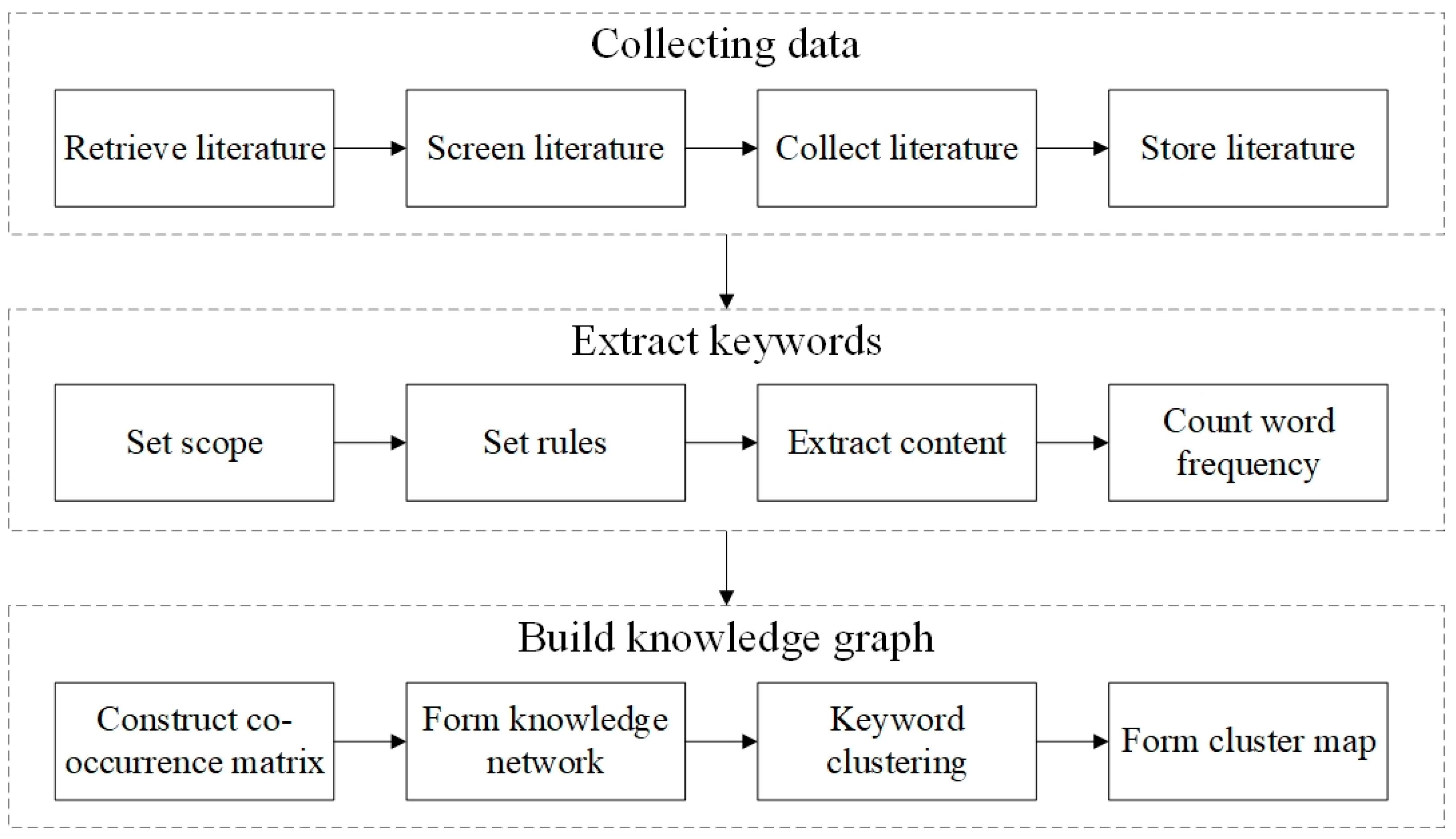
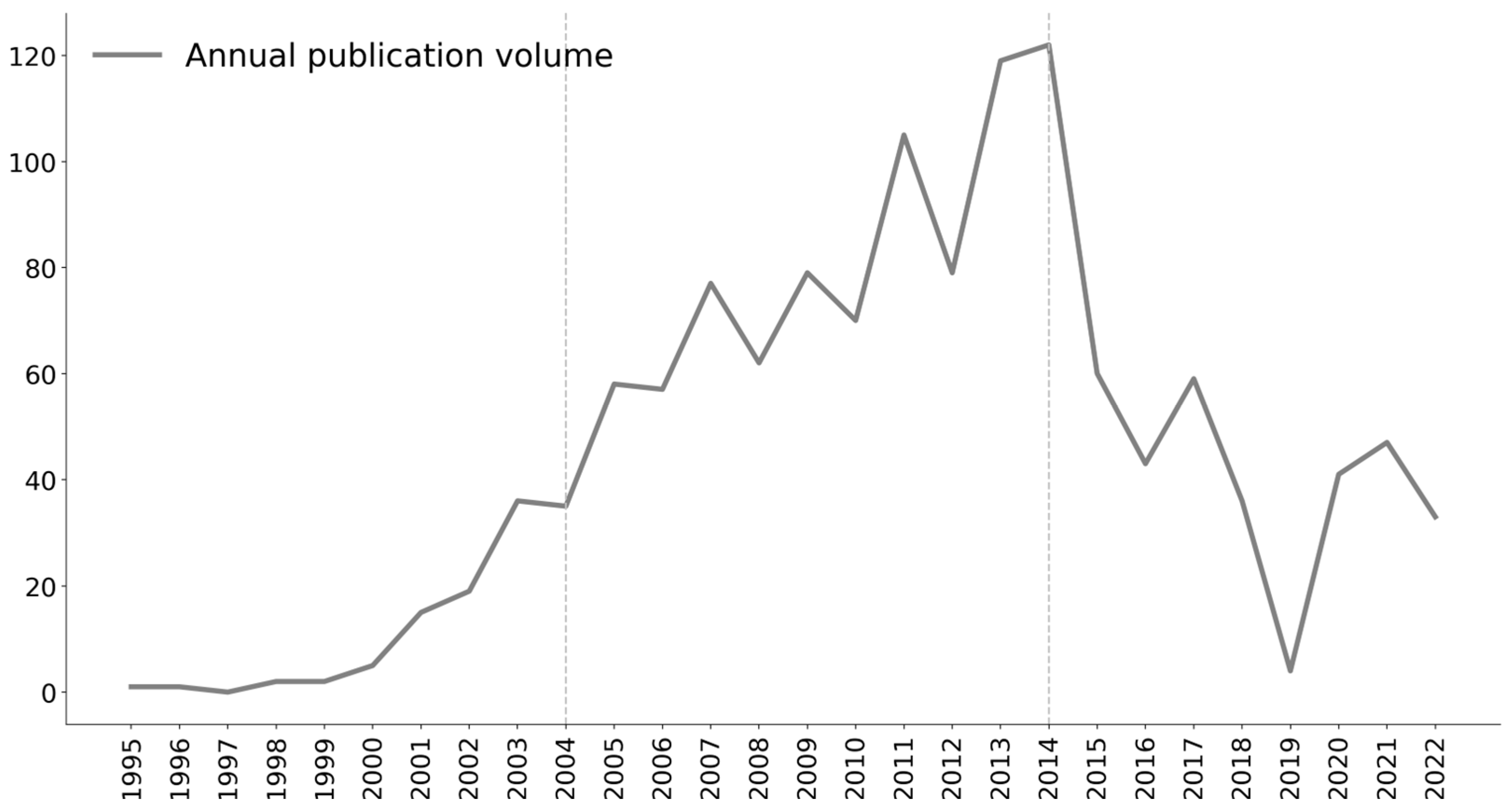
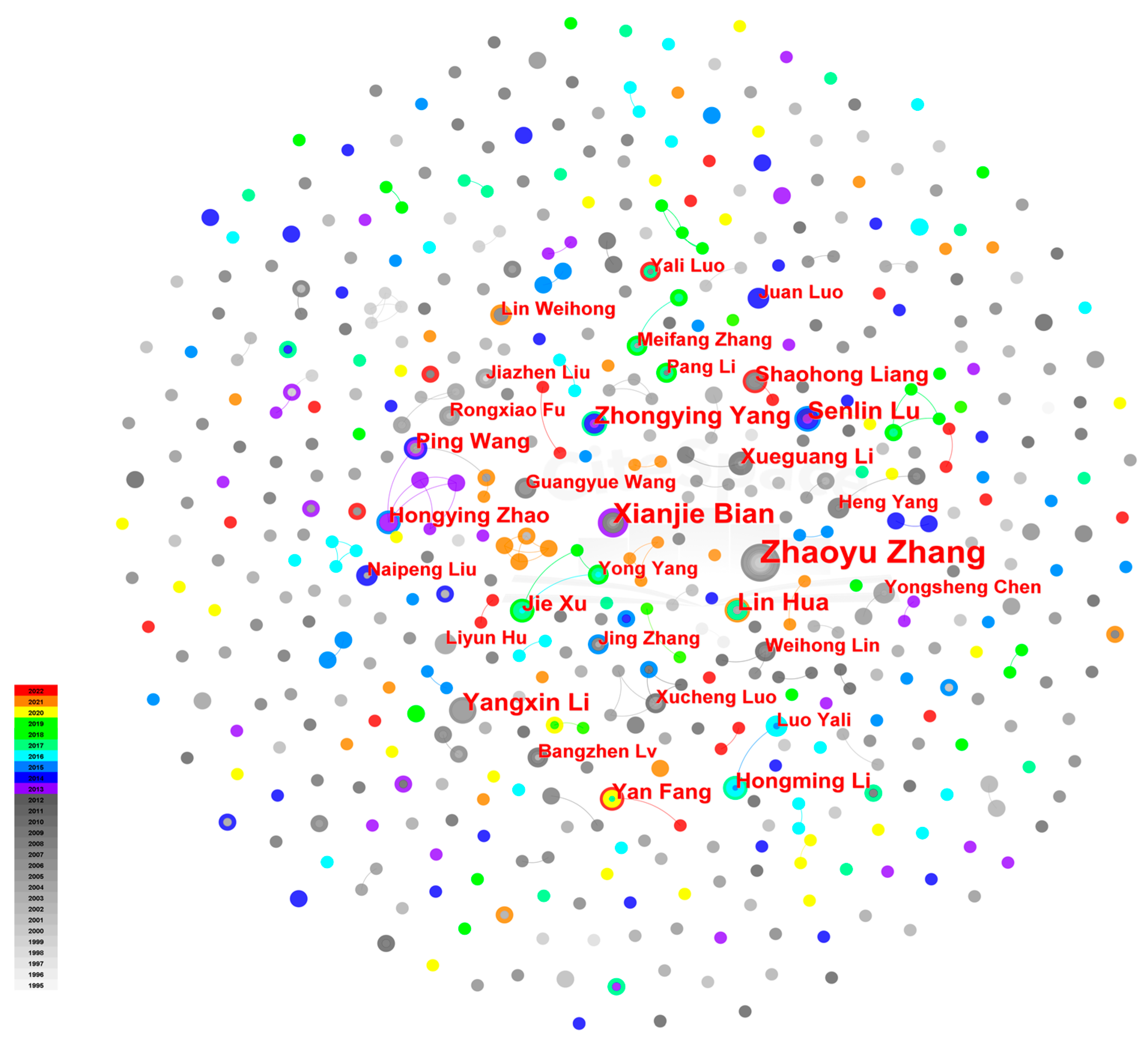
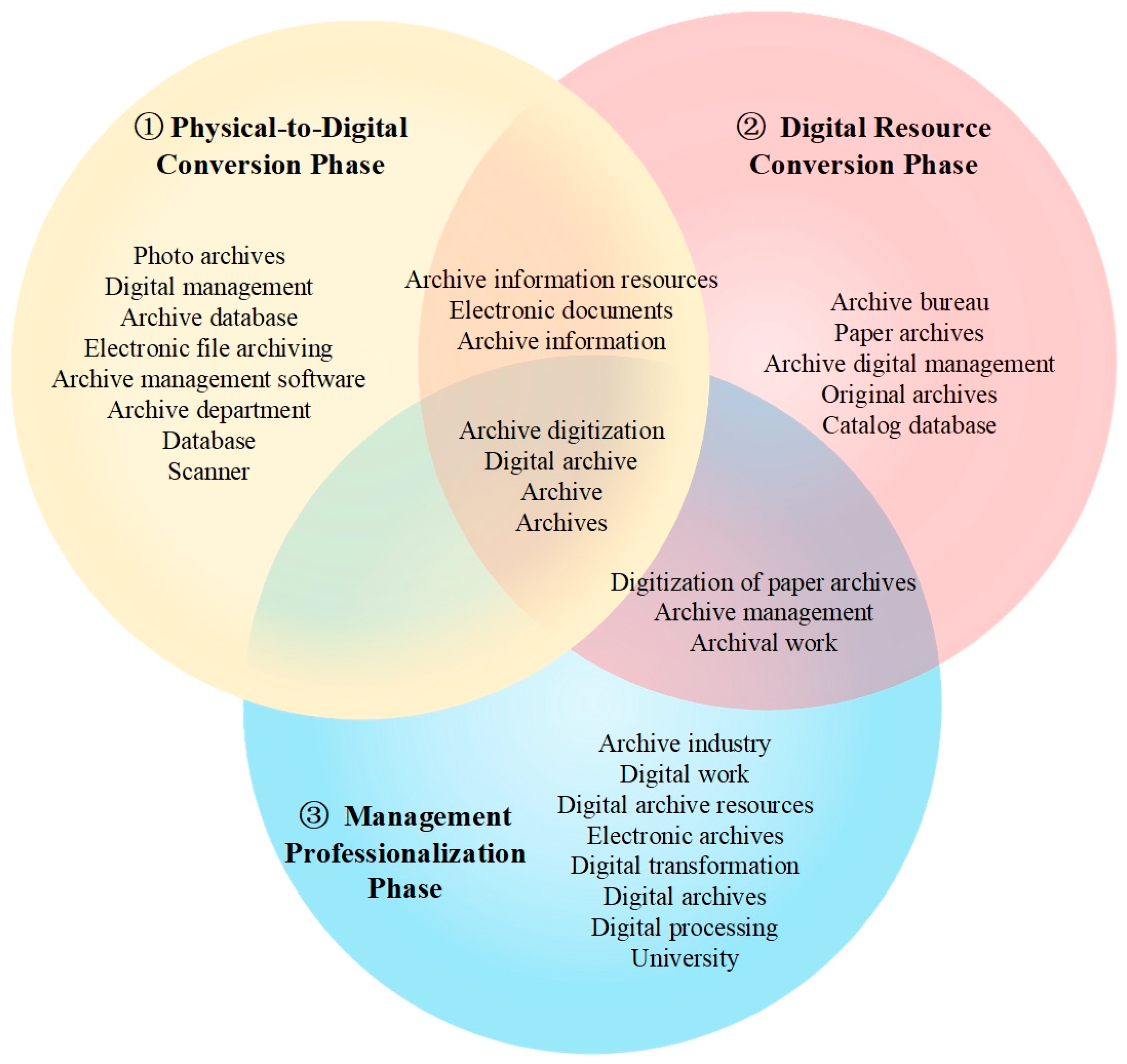
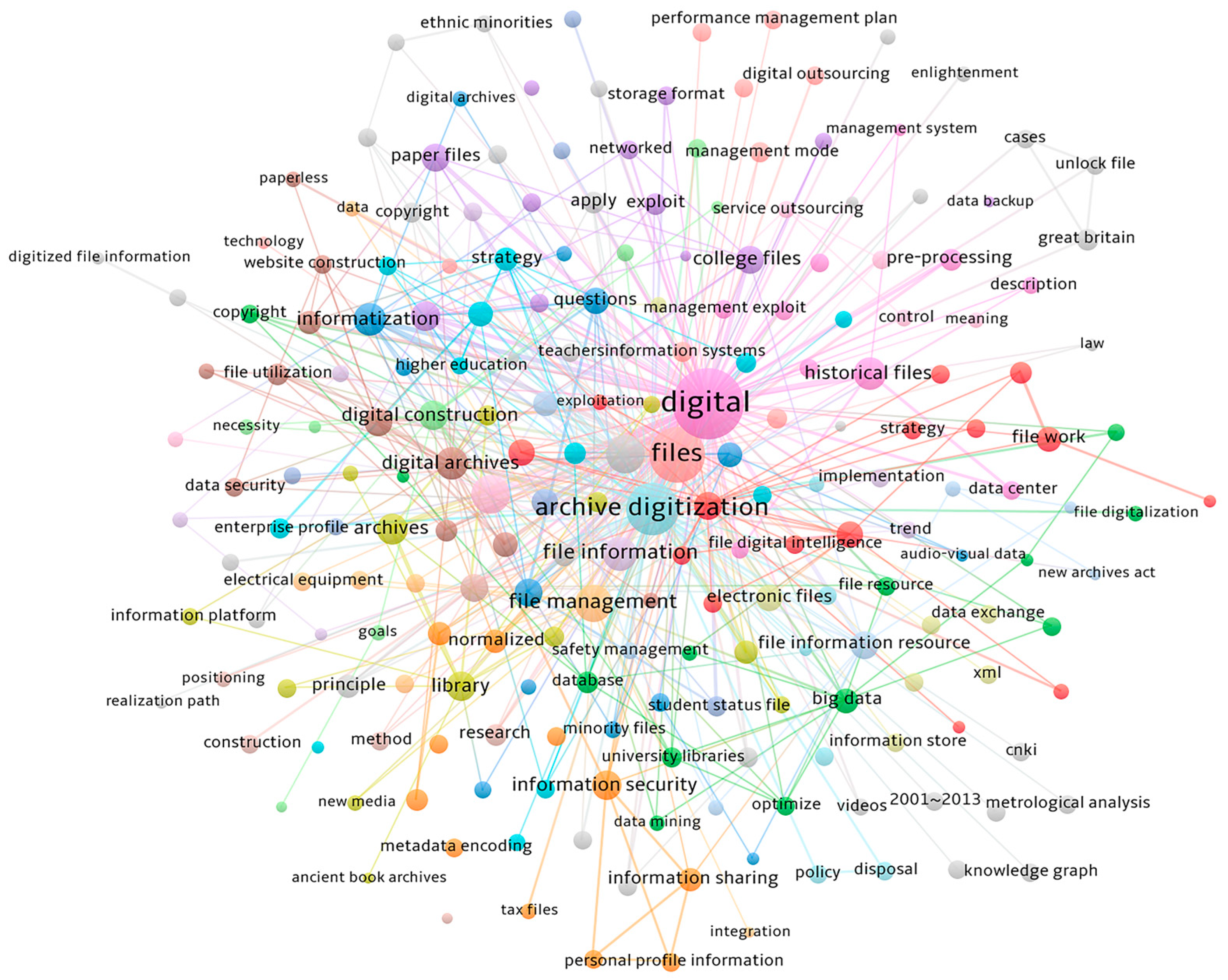
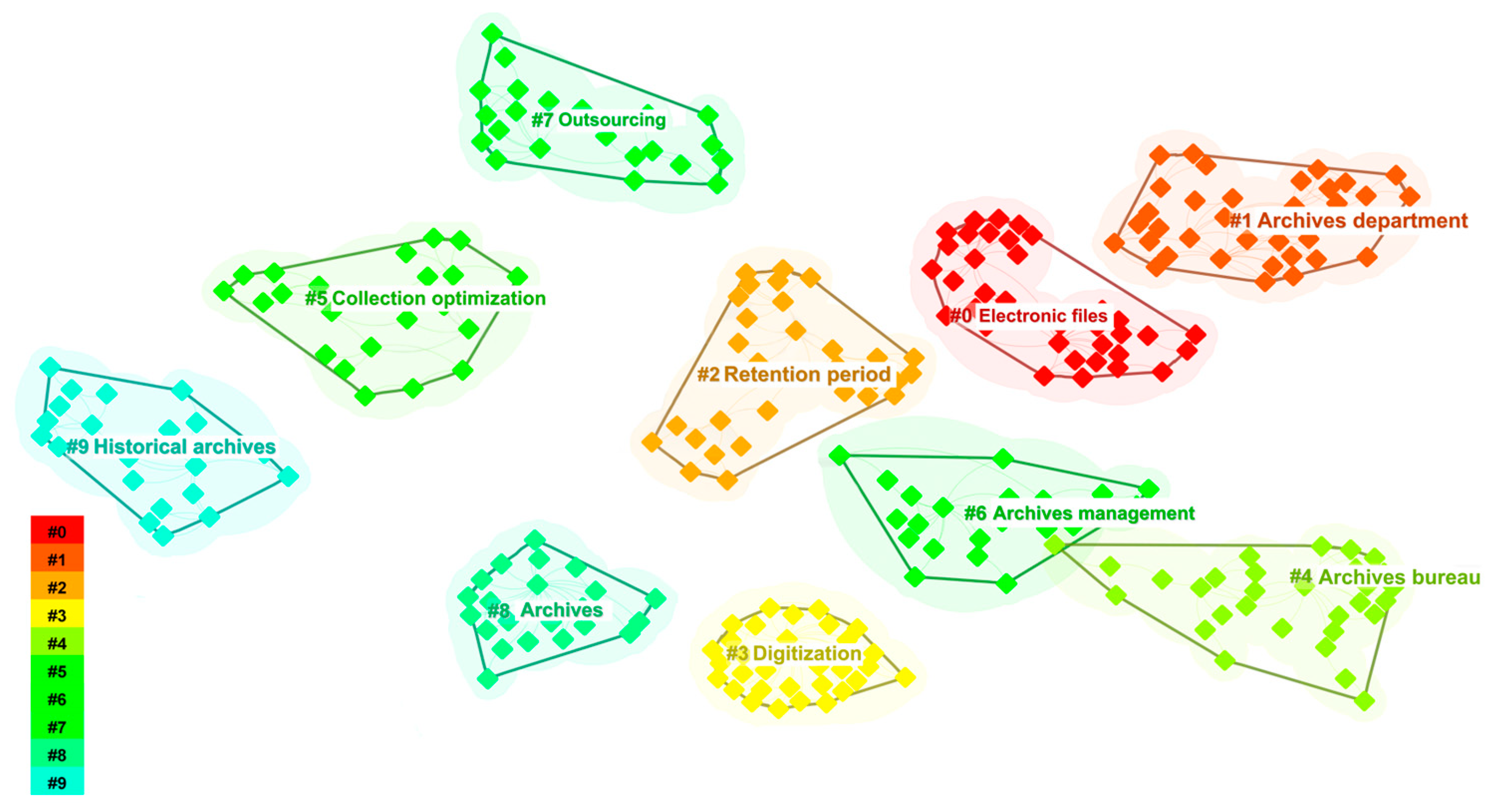
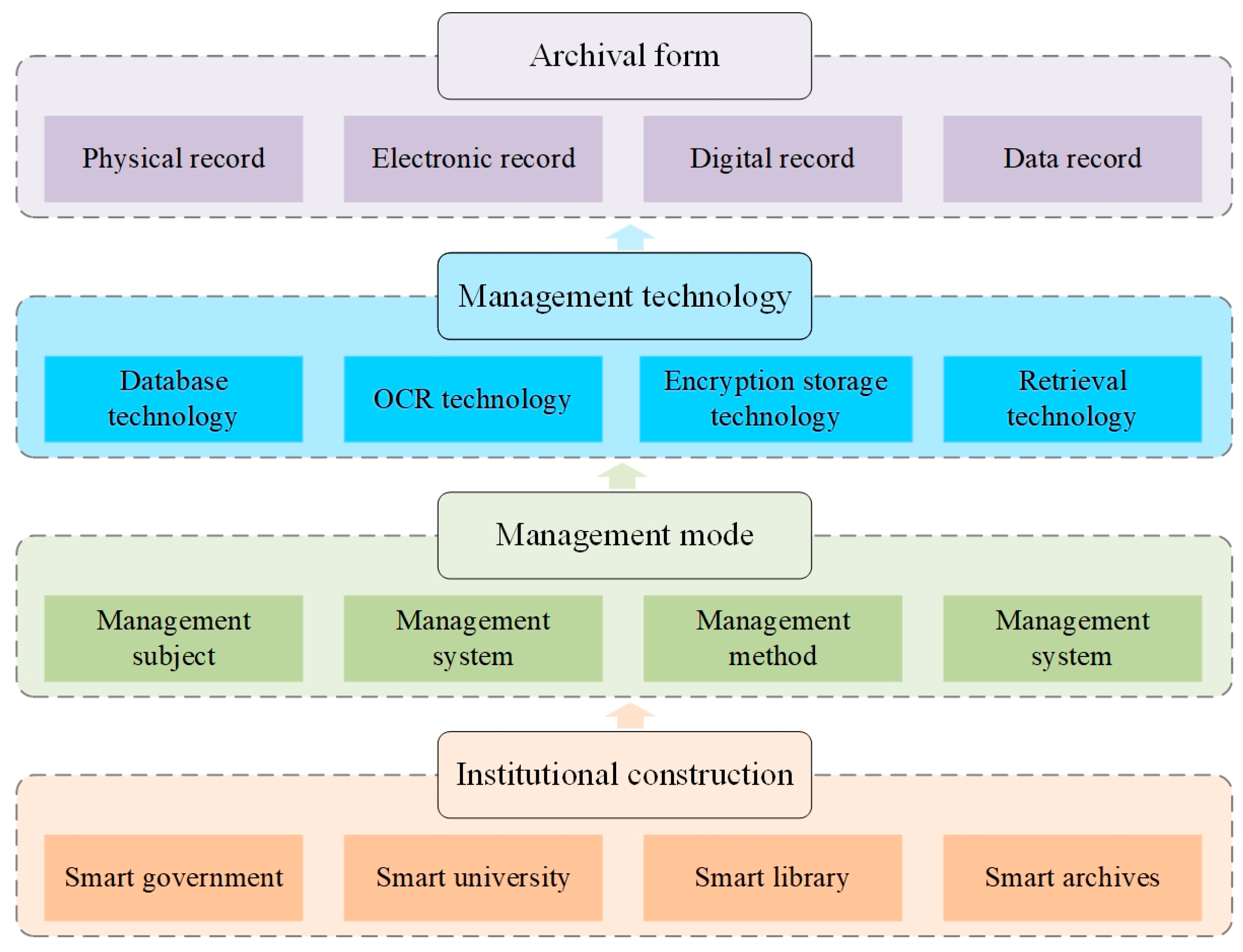
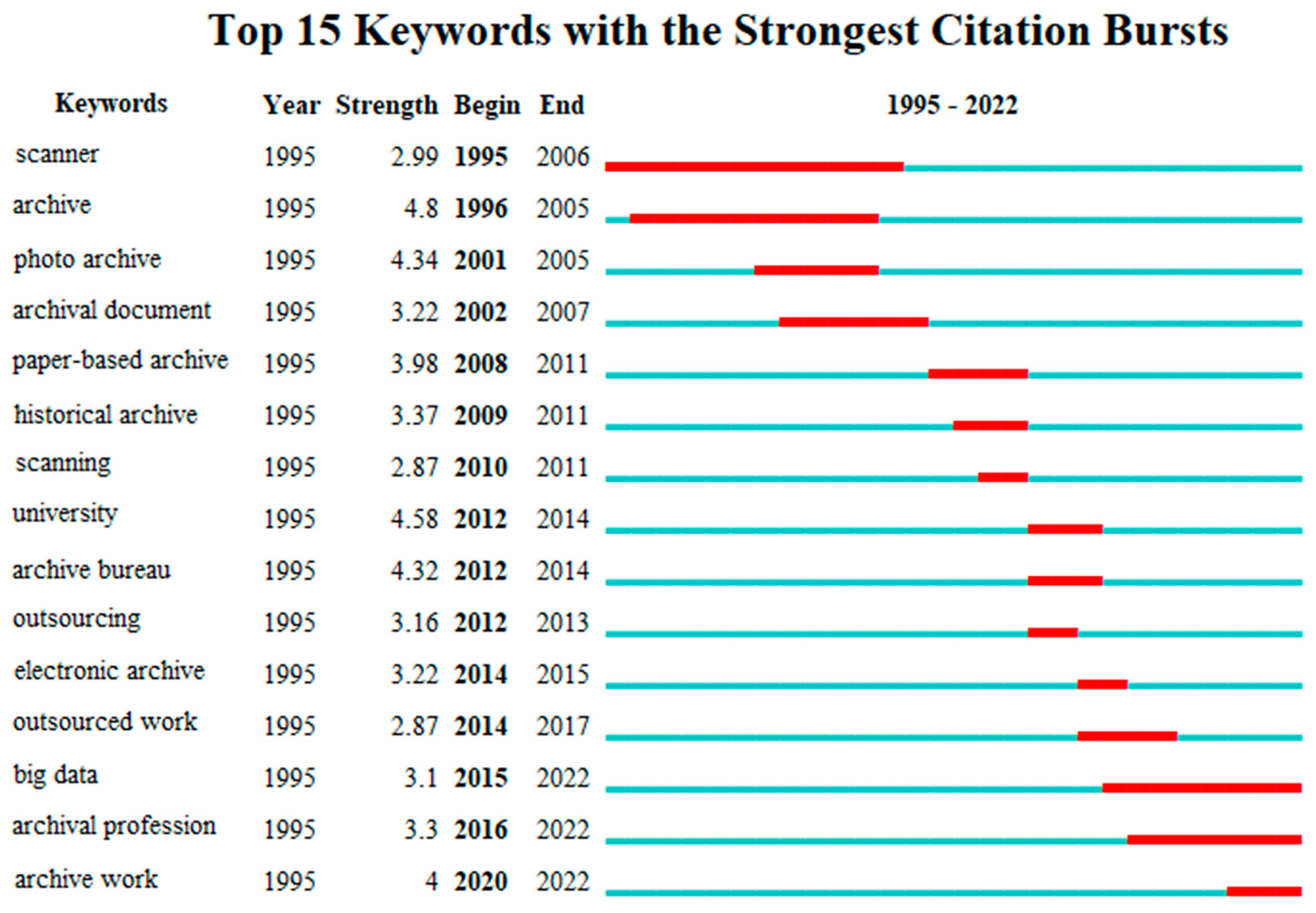
| Ranking | Author | Frequency | Percentage/% | Institution | Research Direction |
|---|---|---|---|---|---|
| 1 | Zhaoyu Zhang | 10 | 0.789 | Yancheng Teachers University | Archives and Museums; Administrative Law and Local Governance; Computer Software and Computer Applications; |
| 2 | Xianjie Bian | 7 | 0.553 | Yancheng Teachers University | Archives and Museums; Computer Software and Computer Applications; Library and Information Science with Digital Libraries; |
| 3 | Yali Luo | 6 | 0.474 | Zhejiang University | Archives and Museums; Higher Education; Civil and Commercial Law; |
| 3 | Weihong Lin | 6 | 0.474 | Zhejiang Provincial Archives | Archives and Museums; Computer Software and Computer Applications; Administration and National Governance; |
| 5 | Xueguang Li | 5 | 0.395 | Changchun City Archives | Archives and Museums; Mathematics; Computer Software and Computer Applications; |
| 5 | Hua Lin | 5 | 0.395 | Yunnan University | Archives and Museums; Modern Chinese History; Administration and National Governance; |
| 5 | Ping Wang | 5 | 0.395 | China People’s Public Security University | Library and Information Science with Digital Libraries; Archives and Museums; Computer Software and Computer Applications; |
| 5 | Yangxin Li | 5 | 0.395 | Sun Yat-Sen University | Archives and Museums; Administrative Law and Local Governance; Research on Health Policies and Regulations; |
| 5 | Senlin Lu | 5 | 0.395 | Jiangxi Science and Technology Normal University | Archives and Museums; Higher Education; Tourism; |
| 5 | Hongying Zhao | 5 | 0.395 | Jilin University | Archives and Museums; Library and Information Science with Digital Libraries; Computer Software and Computer Applications; |
| 5 | Zhongying Yang | 5 | 0.395 | Beijing Municipal Archives Bureau | Archives and Museums; Computer Software and Computer Applications; |
| Ranking | Institution Name | Frequency | Percentage/% |
|---|---|---|---|
| 1 | School of Information Resource Management, Renmin University of China | 23 | 1.7437 |
| 2 | Zhejiang Provincial Archives | 13 | 0.9856 |
| 3 | National Archives Administration of China | 11 | 0.8340 |
| 4 | The Second Historical Archives of China | 9 | 0.6823 |
| 5 | School of Management, Jilin University | 7 | 0.5307 |
| 6 | Department of Library, Information and Archives, Shanghai University | 6 | 0.4549 |
| 7 | School of Public Administration, Yunnan University | 6 | 0.4549 |
| 8 | The First Historical Archives of China | 6 | 0.4549 |
| 9 | School of Public Administration, Sichuan University | 6 | 0.4549 |
| 10 | Liaoning Provincial Archives | 6 | 0.4549 |
| Phase | 1995–2004 | 2005–2014 | 2015–2022 | 1995–2022 |
|---|---|---|---|---|
| Quantity | 27 | 239 | 136 | 288 |
| Cumulative Percentage (%) | 41.291 | 60.352 | 48.166 | 62.213 |
| Ranking | 1995–2004 | F | 2005–2014 | F | 2015–2022 | F | 1995–2022 | F |
|---|---|---|---|---|---|---|---|---|
| 1 | Archive digitization | 89 | Archive digitization | 619 | Archive digitization | 218 | Archive digitization | 873 |
| 2 | Archive | 17 | Archive | 69 | Archive | 33 | Digital archive | 94 |
| 3 | Digital archive | 12 | Archives | 59 | Archive work | 30 | Archive | 87 |
| 4 | Archives | 10 | Electronic files | 53 | Archive management | 29 | Archives | 81 |
| 5 | Archive information resources | 8 | Digitization of paper records | 52 | Digital archive | 28 | Electronic files | 55 |
| 6 | Photo archive | 6 | Archives bureau | 51 | Archive industry | 22 | Digitization of paper archives | 50 |
| 7 | Electronic files | 6 | Paper archives | 45 | Digitization of paper archives | 22 | Paper archives | 45 |
| 8 | Database | 5 | Digital archive | 42 | Archives | 22 | Archive digital management | 43 |
| 9 | Archive information | 5 | Archive management | 35 | Digital work | 15 | Archive information resources | 41 |
| 10 | Digital management | 5 | Archive digital management | 35 | Digital processing | 14 | Archive management | 39 |
| 11 | Archive database | 5 | Original archives | 32 | Digital archive resources | 14 | Archive information | 36 |
| 12 | Electronic file archiving | 4 | Archive information | 31 | Electronic archives | 14 | Catalog database | 31 |
| 13 | Scanner | 4 | Archive work | 29 | Digital transformation | 13 | Archives bureau | 30 |
| 14 | Archive department | 4 | Catalog database | 29 | Digital archives | 12 | Digital processing | 30 |
| 15 | Archive management software | 3 | Archive information resources | 28 | University | 12 | Digital archives | 30 |
| Type | Cluster Code | Cluster Name | Main Nodes |
|---|---|---|---|
| Institutional construction | #1 | Archives department | University, Grassroots archives, Educational administration departments, Teaching archives, Archive work, Archive utilization, Professional ethics |
| #4 | Archives bureau | District archives, County-level archives, Sichuan province, Lishui city, Public archives, Livelihood archives, Medical insurance archives, Promoting development | |
| Management mode | #6 | Archives management | Business processes, Integration, Digitization, Electronic school affairs, Quality control, Professional growth, Archive data, Exploration design |
| #2 | Retention period | Filing scope, Work standards, Archivists, Storage formats, Cold storage rooms, Protective materials, Nitrogen-filled packaging, Plastic bags | |
| #5 | Collection optimization | Optimization, Collection of archives, Value appraisal, Preservation value, Preservation and utilization, Archive management, Paperless, Read-only CD | |
| #7 | Outsourcing | Service outsourcing, Insourcing, Control, Security risks, Measures, Data backup, Benefits, Crowdsourcing, Outsourcing parties | |
| Management technology | #3 | Digitization | Artificial intelligence, Big databases, Experimental design, Data conversion, Technical conditions, Development practice | Development and utilization, Shared platforms |
| Archival form | #8 | Archives | Multiple carriers, Storage, Agricultural archives, Books, Storage, Multimedia, Hydrological yearbook, Classification system |
| #0 | Electronic files | Digital age, Document preservation, Information portal, Information retrieval, Information storage, Inevitable trend, Cloud technology, Offsite backup | |
| #9 | Historical archives | Ancient books, Protection strategies, Preprocessing, Security control, Certificate value, Principles, People-oriented, Information archives |
Disclaimer/Publisher’s Note: The statements, opinions and data contained in all publications are solely those of the individual author(s) and contributor(s) and not of MDPI and/or the editor(s). MDPI and/or the editor(s) disclaim responsibility for any injury to people or property resulting from any ideas, methods, instructions or products referred to in the content. |
© 2023 by the authors. Licensee MDPI, Basel, Switzerland. This article is an open access article distributed under the terms and conditions of the Creative Commons Attribution (CC BY) license (https://creativecommons.org/licenses/by/4.0/).
Share and Cite
Zhang, Y.; Zhang, J.; Qi, L. Analysis of Hotspots and Trends in Digitalization Research of Chinese Archives Based on Bibliometrics. Sustainability 2023, 15, 7679. https://doi.org/10.3390/su15097679
Zhang Y, Zhang J, Qi L. Analysis of Hotspots and Trends in Digitalization Research of Chinese Archives Based on Bibliometrics. Sustainability. 2023; 15(9):7679. https://doi.org/10.3390/su15097679
Chicago/Turabian StyleZhang, Yu, Jian Zhang, and Lin Qi. 2023. "Analysis of Hotspots and Trends in Digitalization Research of Chinese Archives Based on Bibliometrics" Sustainability 15, no. 9: 7679. https://doi.org/10.3390/su15097679
APA StyleZhang, Y., Zhang, J., & Qi, L. (2023). Analysis of Hotspots and Trends in Digitalization Research of Chinese Archives Based on Bibliometrics. Sustainability, 15(9), 7679. https://doi.org/10.3390/su15097679






